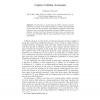62 search results - page 7 / 13 » Minimizing Complexity in Cellular Automata Models of Self-Re... |
CORR
2008
Springer
15 years 1 months ago
2008
Springer
Abstract. We introduce a natural class of cellular automata characterised by a property of the local transition law without any assumption on the states set. We investigate some al...
IJBC
2006
14 years 11 months ago
2006
We study a binary-cell-states eight-cell neighborhood two-dimensional cellular automaton model of a quasi-chemical system with a substrate and a reagent. Reactions are represented...
101
click to vote
GECCO
2004
Springer
15 years 5 months ago
2004
Springer
The Bluenome Model of Development is introduced. The Bluenome model is a developmental model of Artificial Morphogenesis, inspired by biological development, instantiating a subset...
109
click to vote
FGCS
2007
14 years 11 months ago
2007
In this paper we present CAMELotGrid, a tool to manage Grid computations of Cellular Automata that support the efficient simulation of complex systems modeled by a very large numb...
95
Voted
BIOSYSTEMS
2008
14 years 11 months ago
2008
Change of DNA sequence that fuels evolution is, to a certain extent, a deterministic process because mutagenesis does not occur in an absolutely random manner. So far, it has not ...


